 | My
turnouts are all handlaid, but with two types of ties. Of course some of them
are on wood ties, the conventional method. I don't know what frog size turnouts
these are, as they are whatever is needed for the layout being planned. |
 | Most
of my turnouts are laid on Central Valley tie blocks. These are available from
Central Valley and their distributors in a wide variety of frog sizes, right and
lift hand, #4-#9. They are self gauging making life easy. The majority of my turnouts
on the branchline are #5 frog size. |
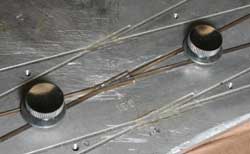 | I
made a jig to use in constructing frogs. It consists of an "X" milled
in a 1/4" thick plate of aluminum at the angles of 1:4; 1:5, and 1:6. Tapped
holes were placed so that thumb screws with washers could be used to hold the
4 necessary rails in place while they were being soldered. The
two pointed frog rails were ground in a grinder. If you are making a bunch at
the same time - the best way to do it - an angle plate can be clamped to your
grinder so that grinding the rail is like putting pencil in a pencil sharpener. For
the other rails, I made another jig. I drilled a hole just large enough for rail
to fit into it in a small block of metal. The hole depth matches the length of
the wing rail. Sticking the raw rail into the hole and then bending it insures
that the wing is always the same length. |
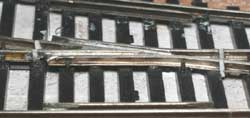 | All
of my frogs are insulated, unpowered. Once the turnout is complete, I gap the
frog on both end and insert styrene held with CA glue. When it sets, the styrene
can be trimmed to match the rail. I
attach electric drops to the point rails as well as to the primary rails. |
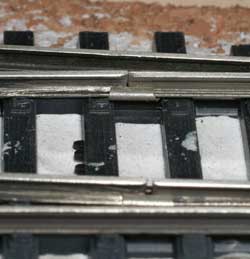 | I
am making points in two different ways. Staging tracks have a continuous rail
from frog to point. There are probably more stable. However, they don't weather
and you can't ballast then in prototypical ways. My
visible turnouts use hinged points. The hinges are 1/2 of a normal rail joiner.
Dremel cutoff disks are best for cutting them. Everything I have done to this
point is in code 70. |
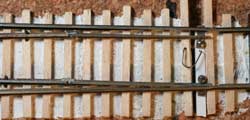 | Hard
to reach turnouts on the layout are controlled by switch motors. Accessible
turnouts are manual with only a spring to hold them in place. I make these springs
out of piano wire. Using the Kadee coupler adjusting pliars, the wire is bent
90 degrees. Such a curved bend is much better than a sharp bend. Then the ends
are bend 90 degrees down and inserted in the throw bar and an adjacent tie. Simple,
and works fine. It helps if the parts to be inserted are not straight down, but
bent slighly away from each other so they won't come out easily. |
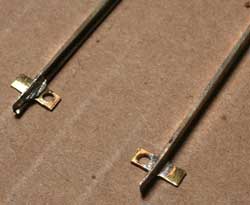 | My
points are first ground with a grinder, then finished with a file. The inside
of the rail head is filed even with the web so that it comes to a strong point. A
piece of .020x.080" brass forms the throw bar connector. It extends long
enough to be under the outside rails when the turnout is open or closed. It keeps
the rail from rising up and maintains electrical conductivity to that outer rail. The
brass is drilled with a #48 drill for a 1-72 screw. I take a piece of brass and
drill holes every 1/4" or so. Again, I have created a jig to help do this.
Then I tin the whole thing. Finally I cut individual pieces to solder to the bottom
of the points. The
points are left longer than needed and can be used for any size of turnout. I
make up a bunch at a time. When the other rails of the turnout are laid, the point
is cut to fit. My
throw bar is .080 x .080 styrene. A #53 hole is drilled and 1-72 screw used to
attach the point rails. |
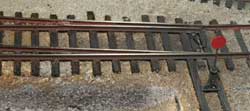 | Now
the turnout is complete. Ballast, weather, and enjoy. One
benefit of this type of construction is that if in ballasting the points stick,
it is easy to unscrew them, remove, and clean the whole area. If points break,
simply replace them. |